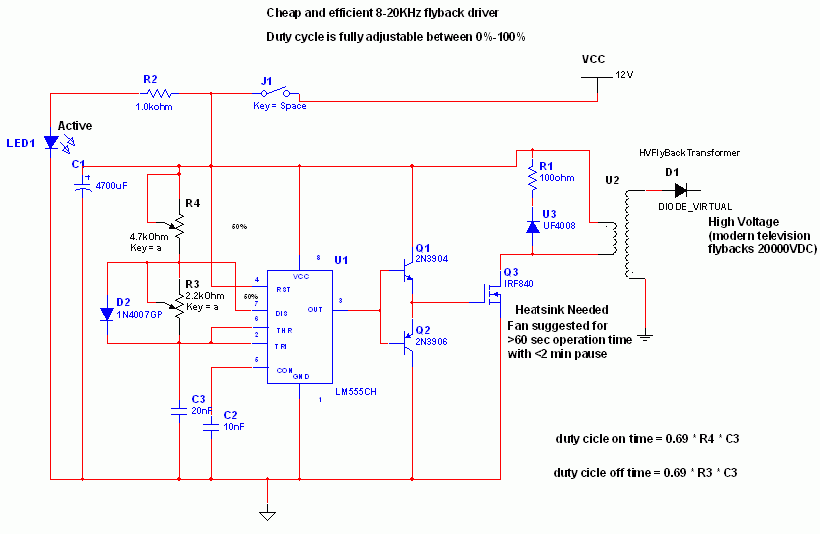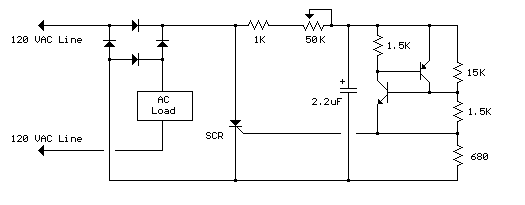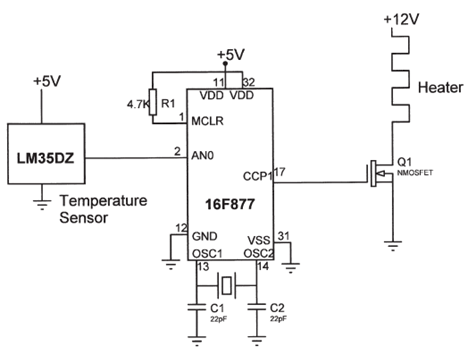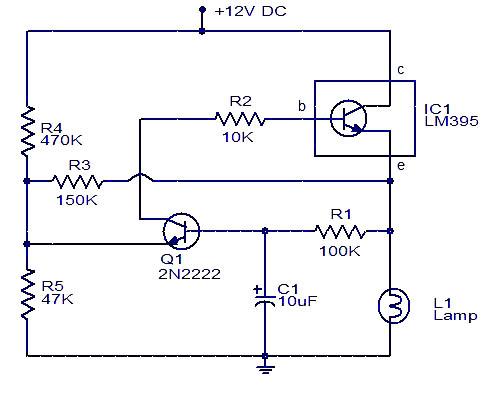
8W Flouroscent lamp driver

This schematic represents a simple fluorescent lamp driver circuit utilizing two transistors. The circuit employs capacitive ballasting to drive an 8 W standard fluorescent tube efficiently. The two transistors (2SC 1983) and their associated components create an oscillator operating at approximately 1 kHz. The configuration of the oscillator prevents the transistors from reaching saturation, enhancing the circuit's efficiency. The circuit produces a clean sine wave with minimal noise. The winding specifications, including the number of turns, are provided in the schematic. It is recommended to use 0.8 mm diameter enameled copper wire for the primary winding and 0.4 mm diameter enameled copper wire for the secondary winding. A ferrite core is suggested for optimal performance, with the primary winding being placed first, followed by the secondary winding on top.
The fluorescent lamp driver circuit is designed to operate efficiently by utilizing two transistors configured as an oscillator. The transistors, specifically the 2SC 1983 model, are chosen for their suitability in switching applications and high-frequency operation. The oscillator generates a frequency of around 1 kHz, which is ideal for driving fluorescent lamps, as it allows for effective excitation of the gas within the tube.
Capacitive ballasting is employed in this design to limit the current flowing through the fluorescent tube, preventing excessive heating and prolonging the lamp's lifespan. The circuit architecture ensures that the transistors do not enter saturation, which is critical for maintaining a stable output and reducing power losses. This design consideration results in a cleaner sine wave output, characterized by low harmonic distortion and minimal electromagnetic interference.
The transformer design is integral to the circuit's operation. The primary winding, constructed with 0.8 mm diameter enameled copper wire, should be wound first around the ferrite core. The secondary winding, made with 0.4 mm diameter enameled copper wire, is then wound on top of the primary. The number of turns for each winding is specified in the schematic, which is crucial for achieving the desired voltage transformation and ensuring that the fluorescent tube operates efficiently.
Overall, this circuit represents a practical and effective solution for driving fluorescent lamps, balancing efficiency, performance, and simplicity in its design.Here is the schematic of a simple flouroscent lamp driver circuit based on two transistors. The circuit uses capacitive ballasting for driving the tube. An 8 W standard flouroscent tube can be efficiently driven using the circuit. The two transistors (2Sc 1983) with associated components forms a oscillator around 1KHz. The oscillator is wired so that saturation condition of the transistors are prohibited. This adds on to the efficiency of the circuit. The circuit produces a clean sine wave with very less noise. The winding details(no of turns) are given in the circuit. Use 0. 8 mm dia enameled copper wire for primary and 0. 4 mm dia enameled copper wire for secondary. The core can be a ferrite core. The primary should be wound first and secondary on top of it. 🔗 External reference
The fluorescent lamp driver circuit is designed to operate efficiently by utilizing two transistors configured as an oscillator. The transistors, specifically the 2SC 1983 model, are chosen for their suitability in switching applications and high-frequency operation. The oscillator generates a frequency of around 1 kHz, which is ideal for driving fluorescent lamps, as it allows for effective excitation of the gas within the tube.
Capacitive ballasting is employed in this design to limit the current flowing through the fluorescent tube, preventing excessive heating and prolonging the lamp's lifespan. The circuit architecture ensures that the transistors do not enter saturation, which is critical for maintaining a stable output and reducing power losses. This design consideration results in a cleaner sine wave output, characterized by low harmonic distortion and minimal electromagnetic interference.
The transformer design is integral to the circuit's operation. The primary winding, constructed with 0.8 mm diameter enameled copper wire, should be wound first around the ferrite core. The secondary winding, made with 0.4 mm diameter enameled copper wire, is then wound on top of the primary. The number of turns for each winding is specified in the schematic, which is crucial for achieving the desired voltage transformation and ensuring that the fluorescent tube operates efficiently.
Overall, this circuit represents a practical and effective solution for driving fluorescent lamps, balancing efficiency, performance, and simplicity in its design.Here is the schematic of a simple flouroscent lamp driver circuit based on two transistors. The circuit uses capacitive ballasting for driving the tube. An 8 W standard flouroscent tube can be efficiently driven using the circuit. The two transistors (2Sc 1983) with associated components forms a oscillator around 1KHz. The oscillator is wired so that saturation condition of the transistors are prohibited. This adds on to the efficiency of the circuit. The circuit produces a clean sine wave with very less noise. The winding details(no of turns) are given in the circuit. Use 0. 8 mm dia enameled copper wire for primary and 0. 4 mm dia enameled copper wire for secondary. The core can be a ferrite core. The primary should be wound first and secondary on top of it. 🔗 External reference





